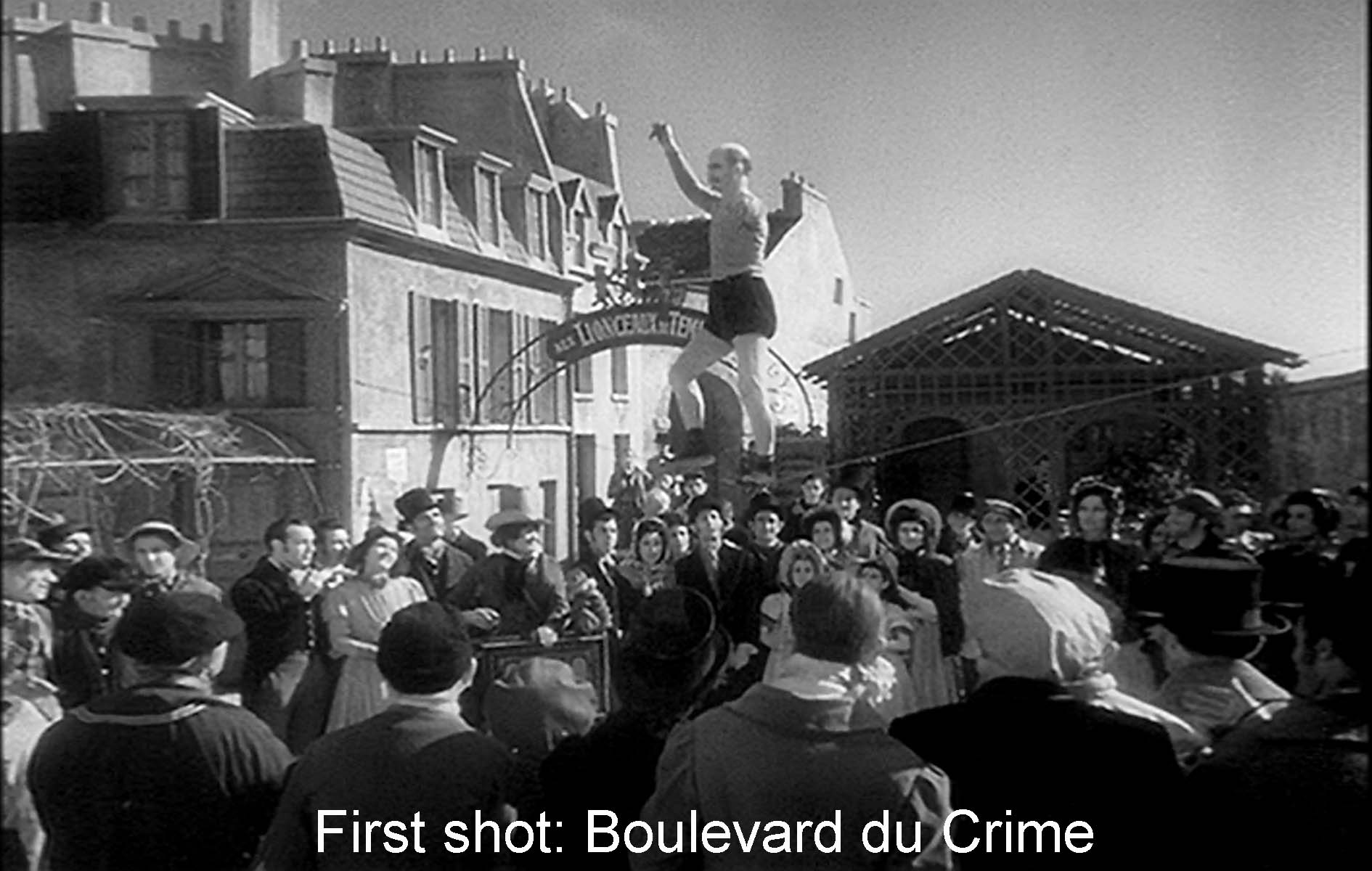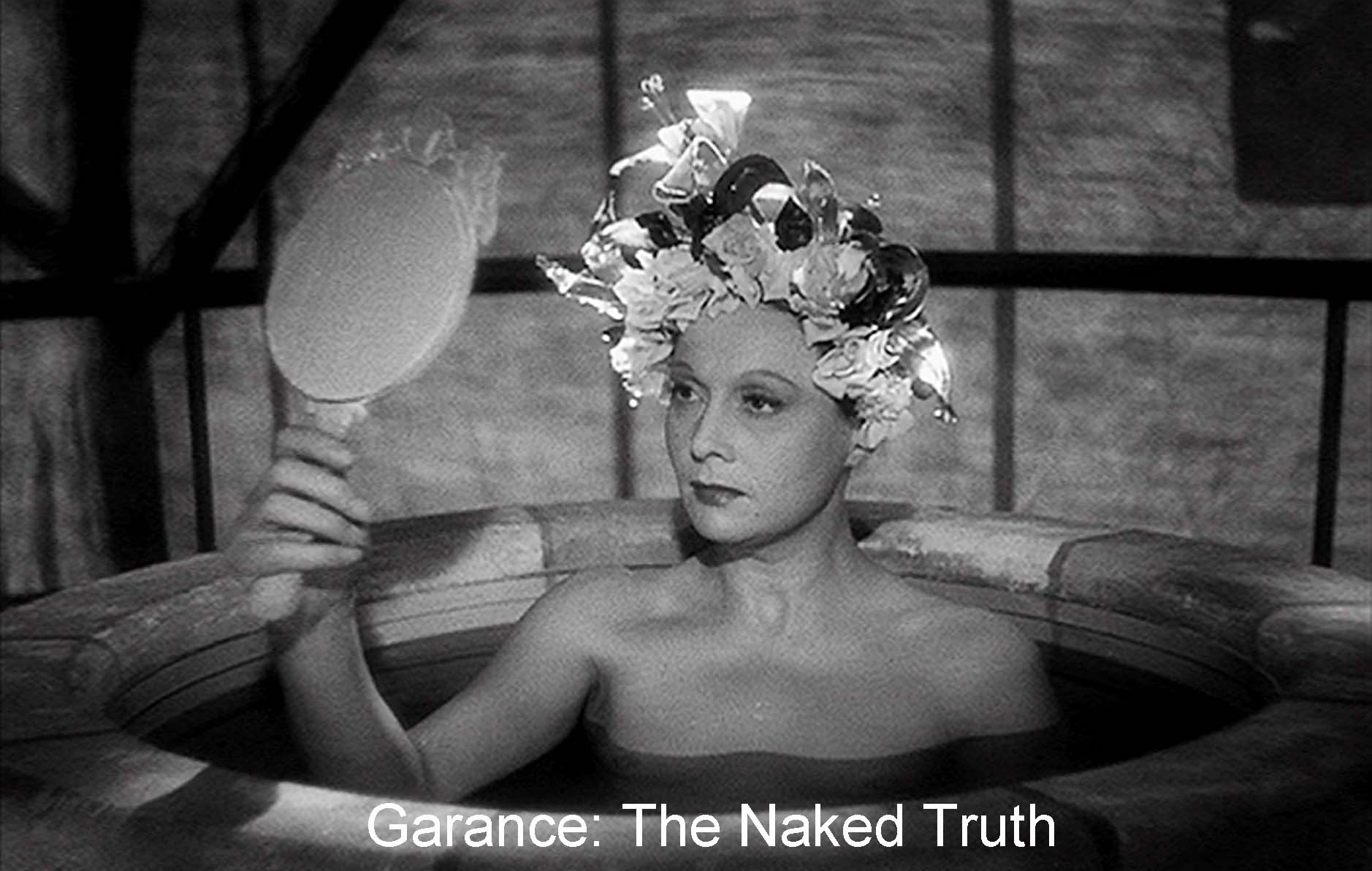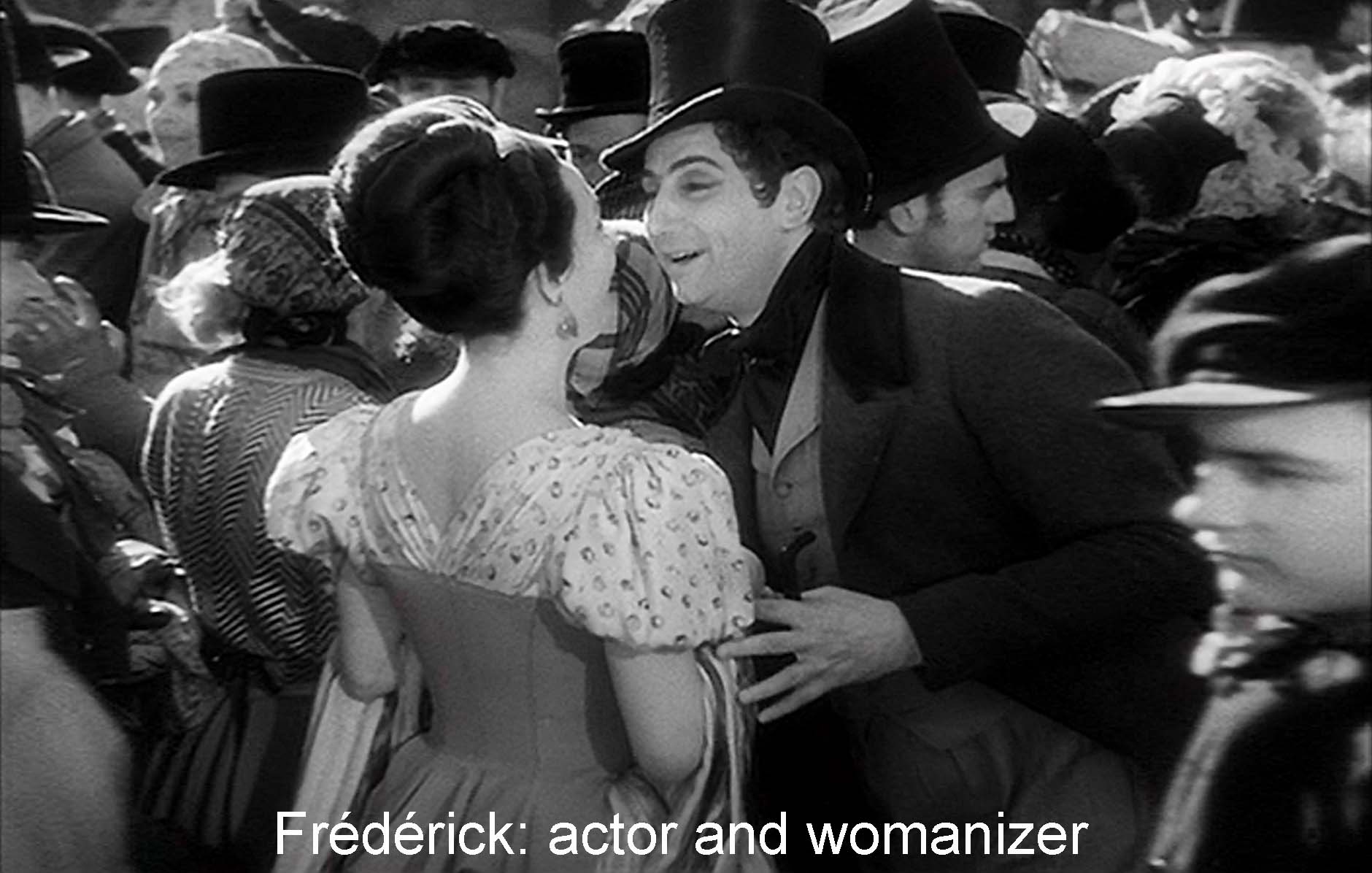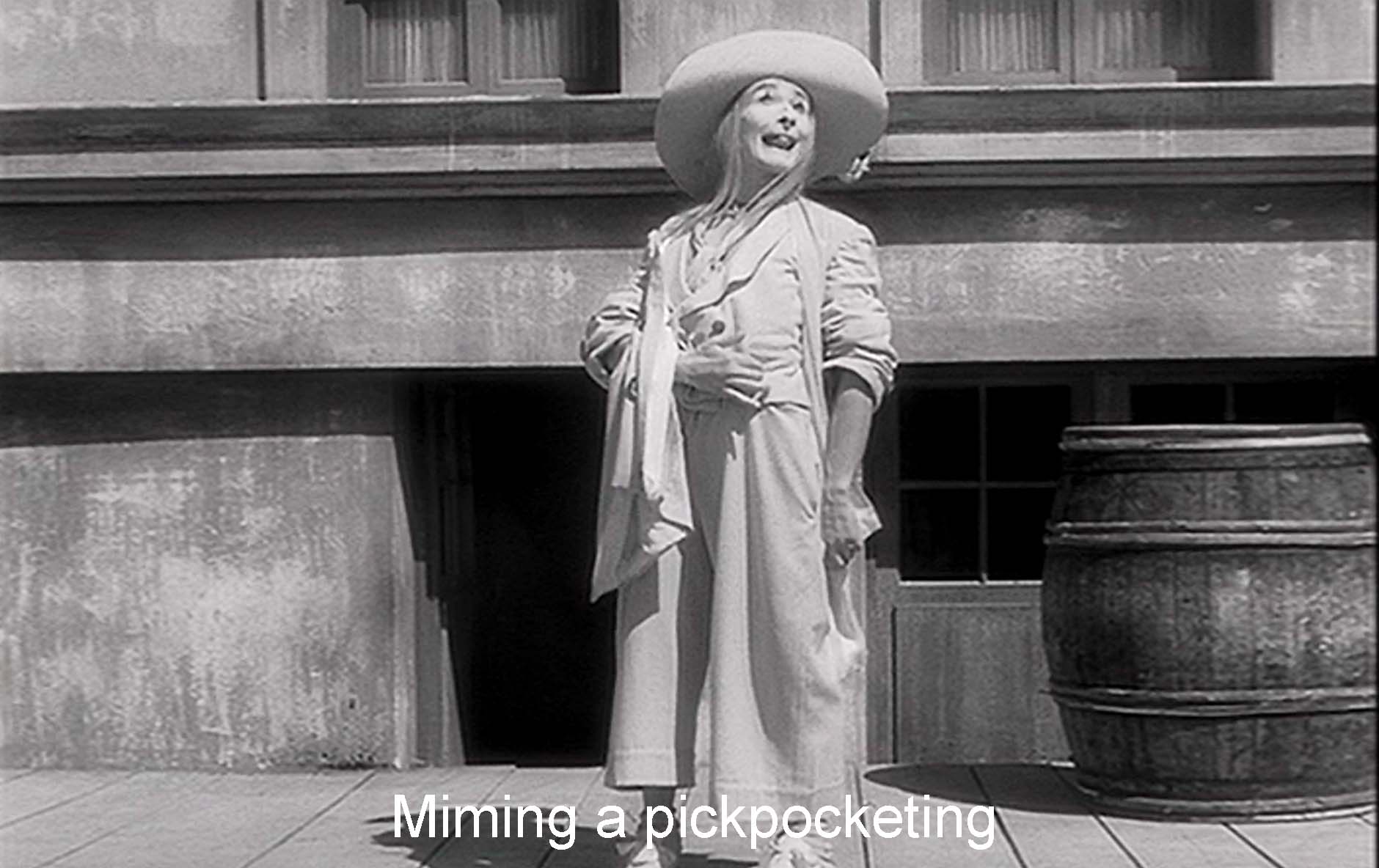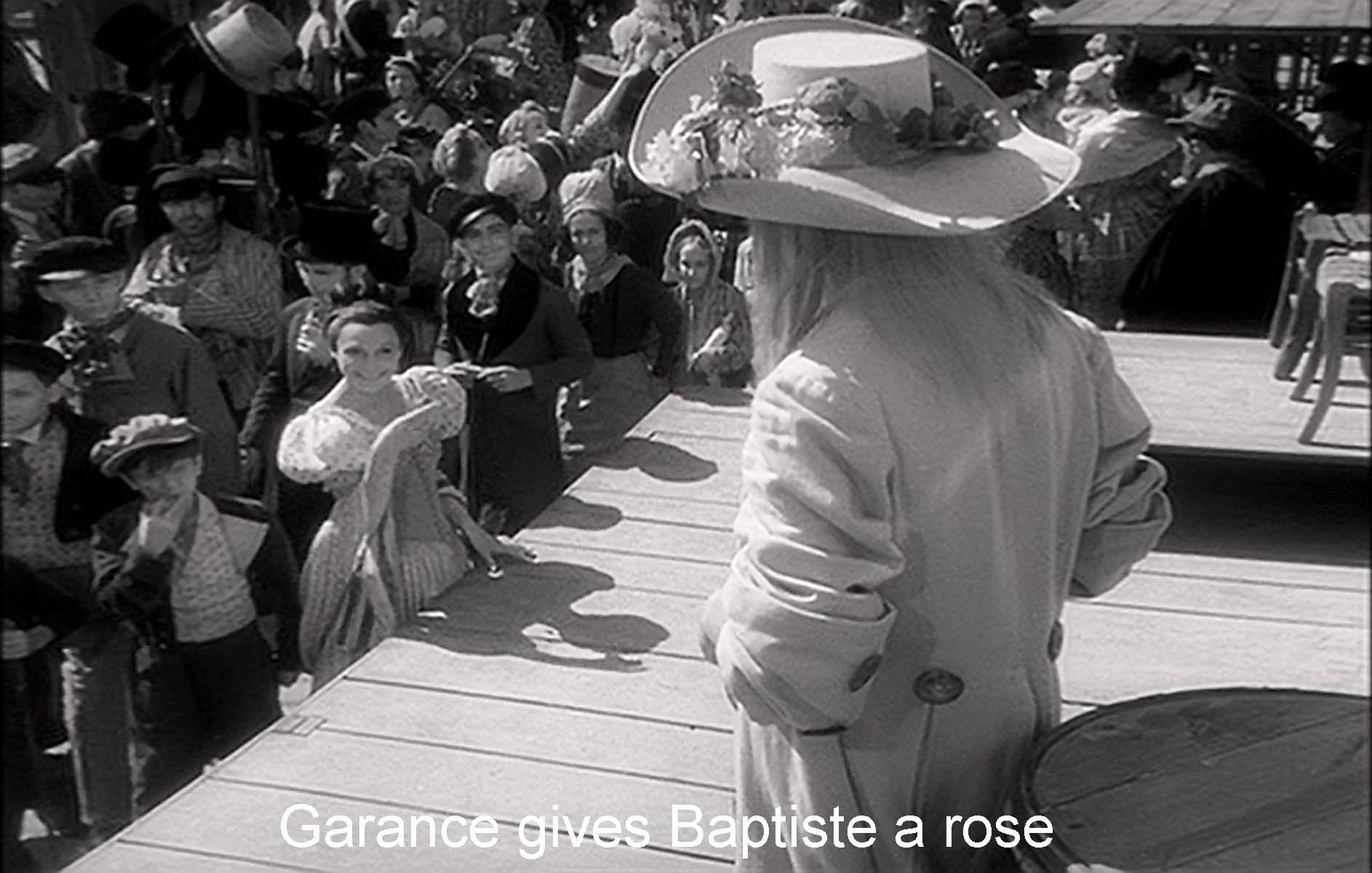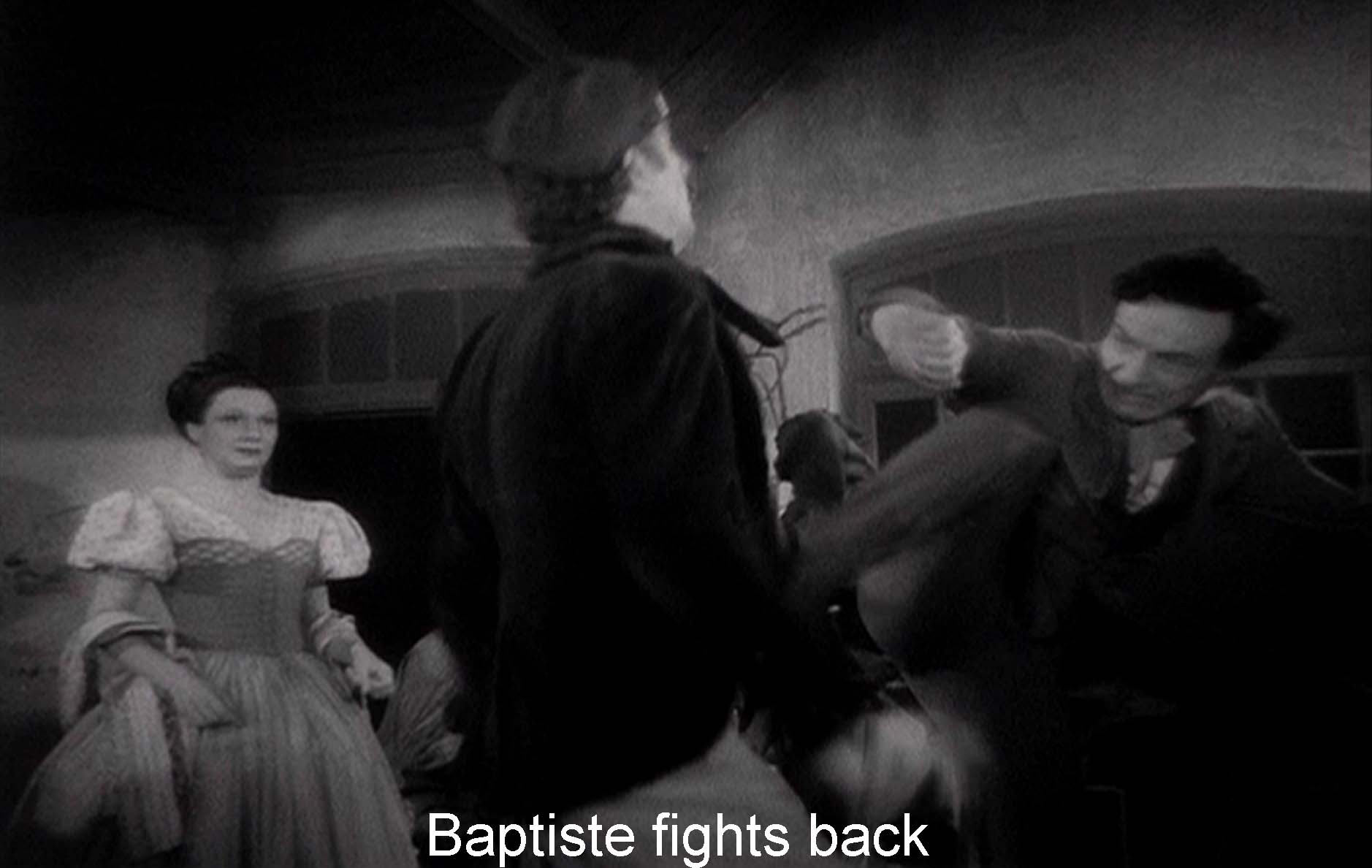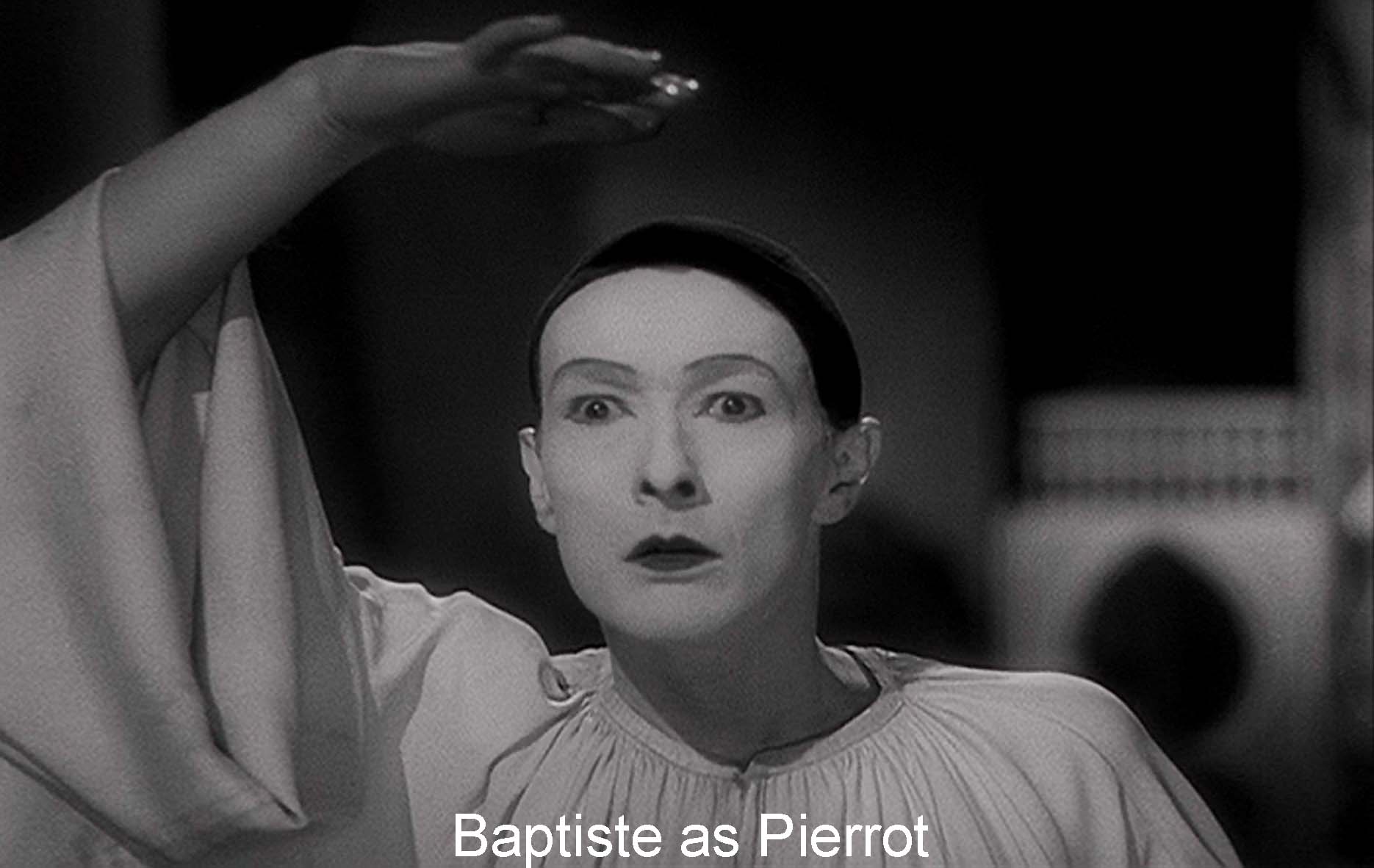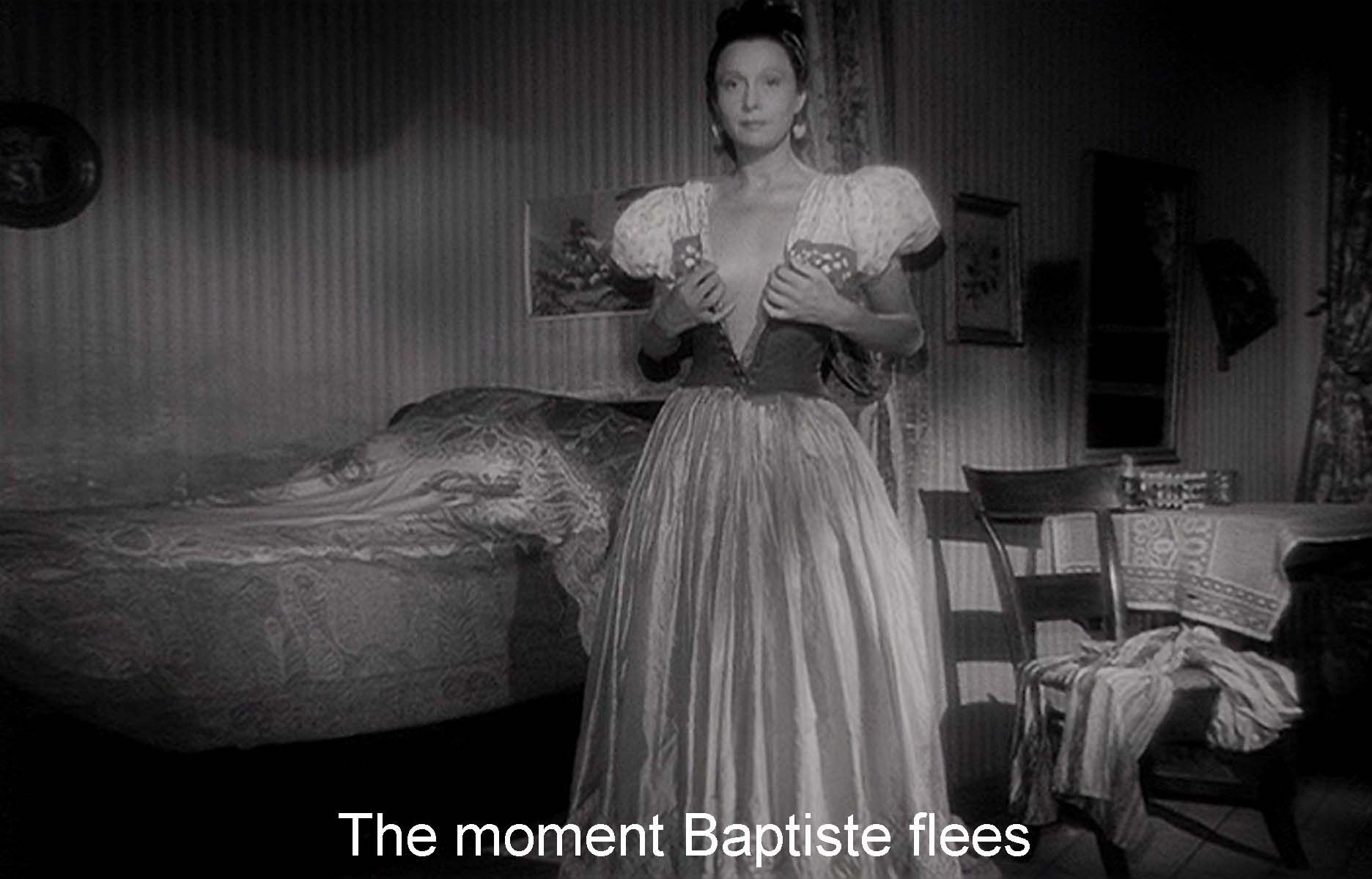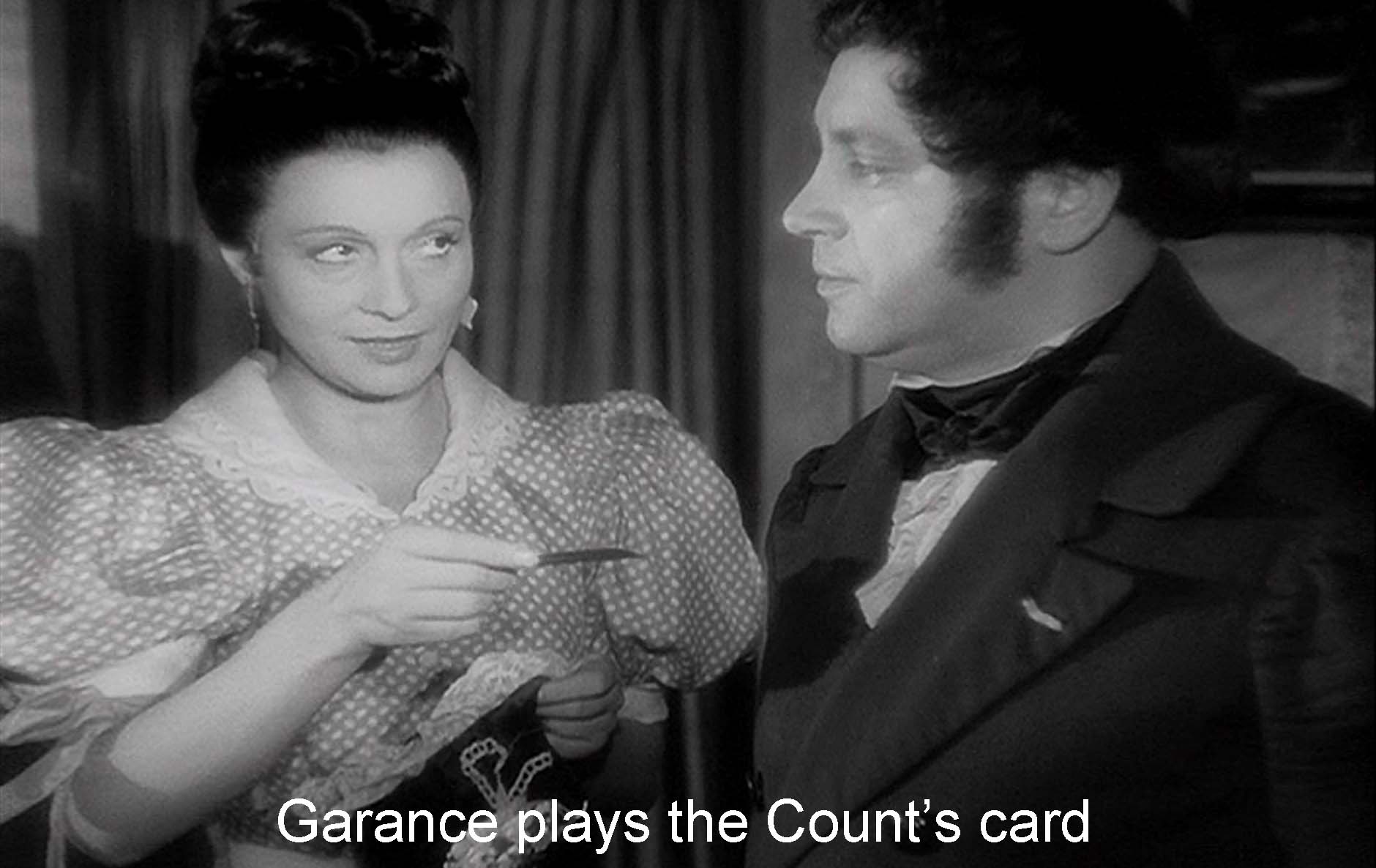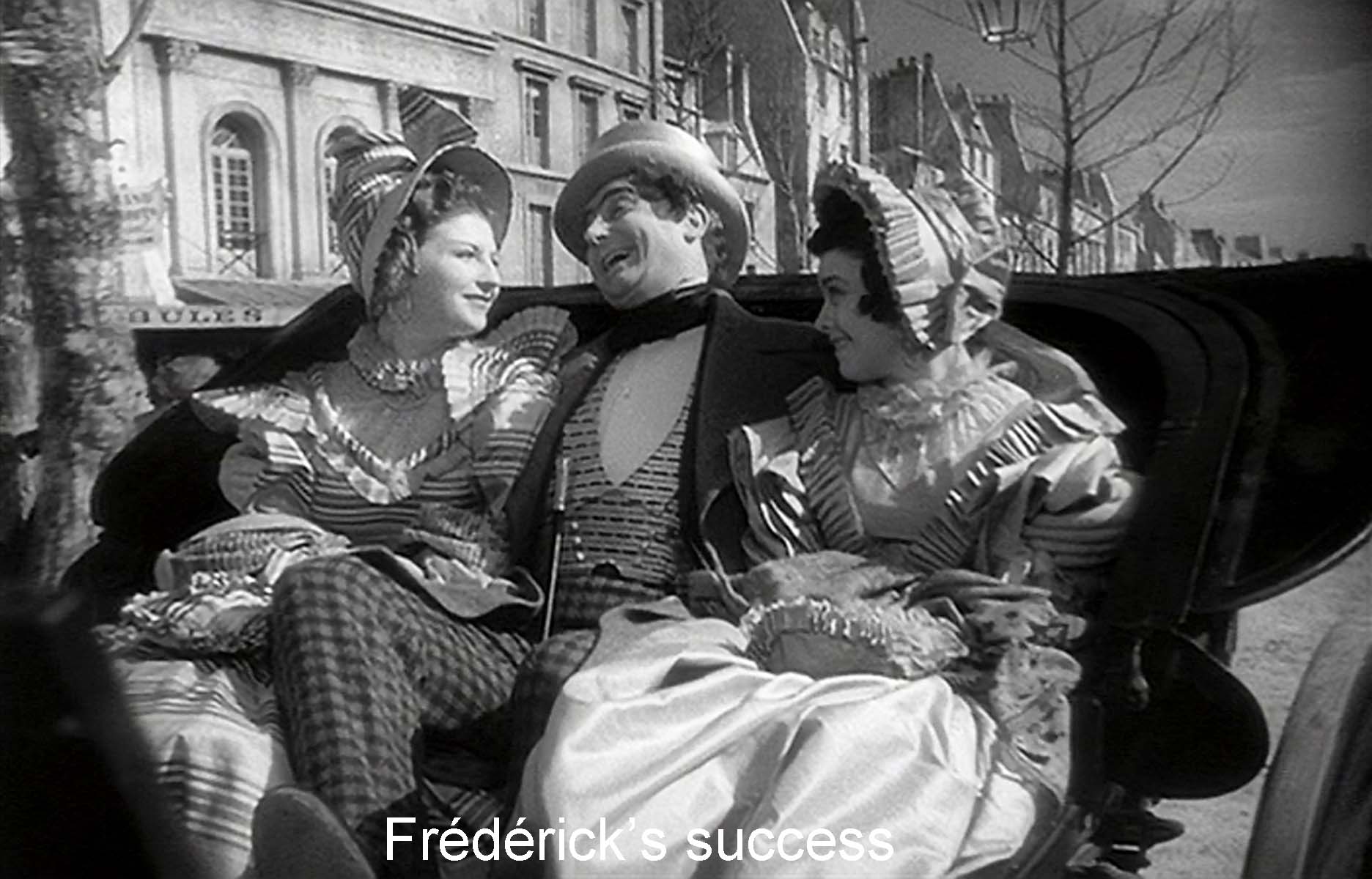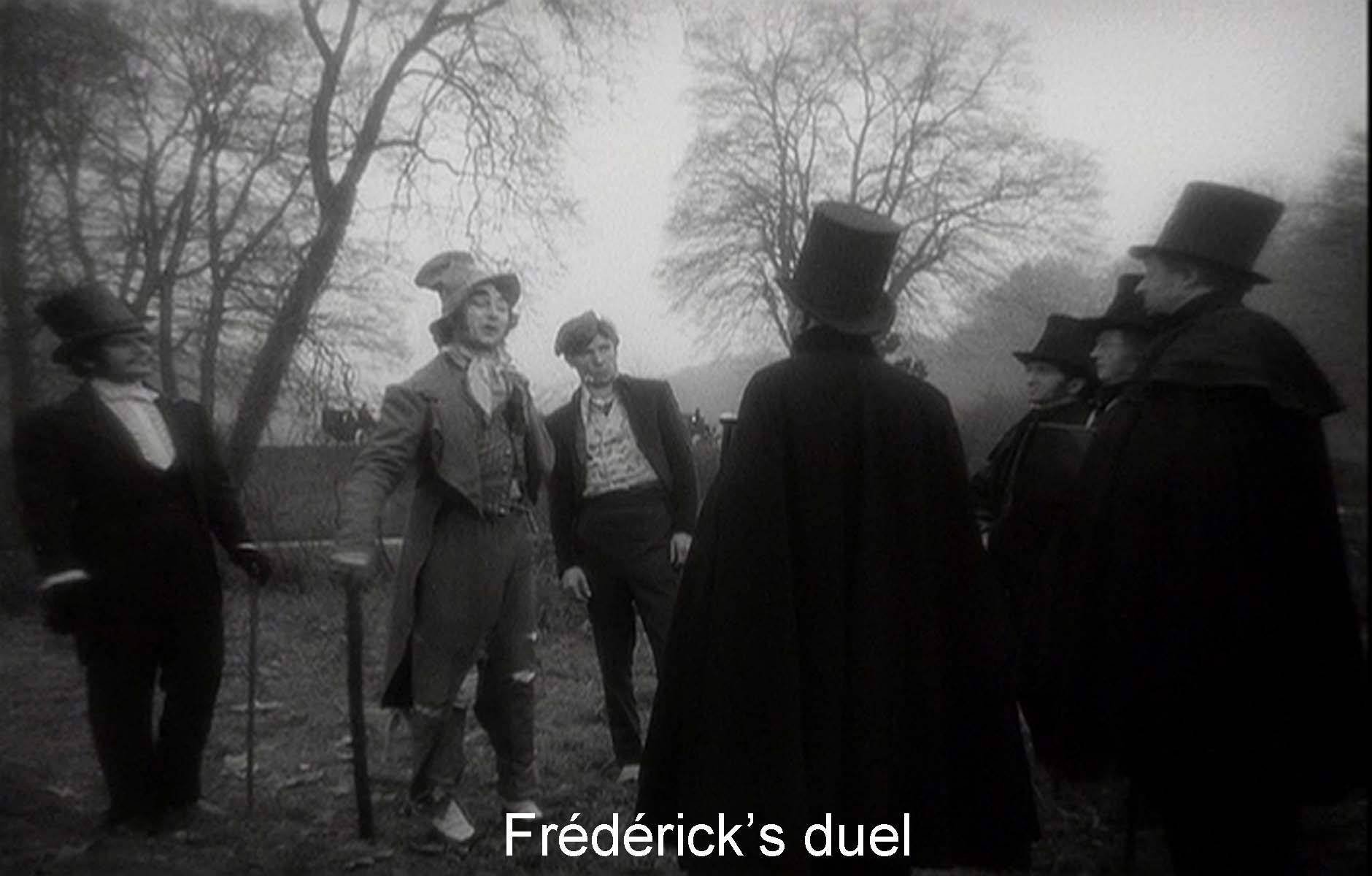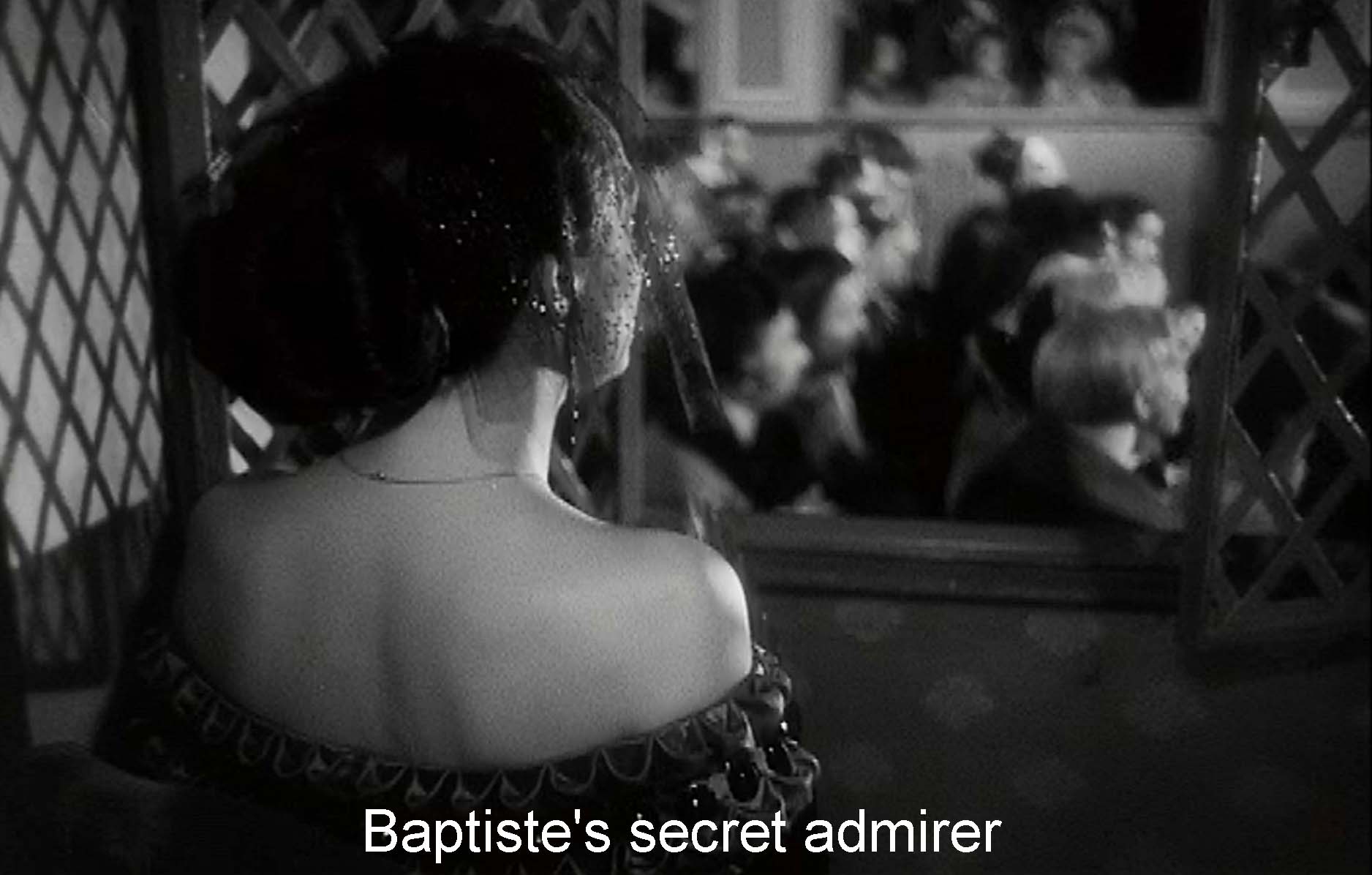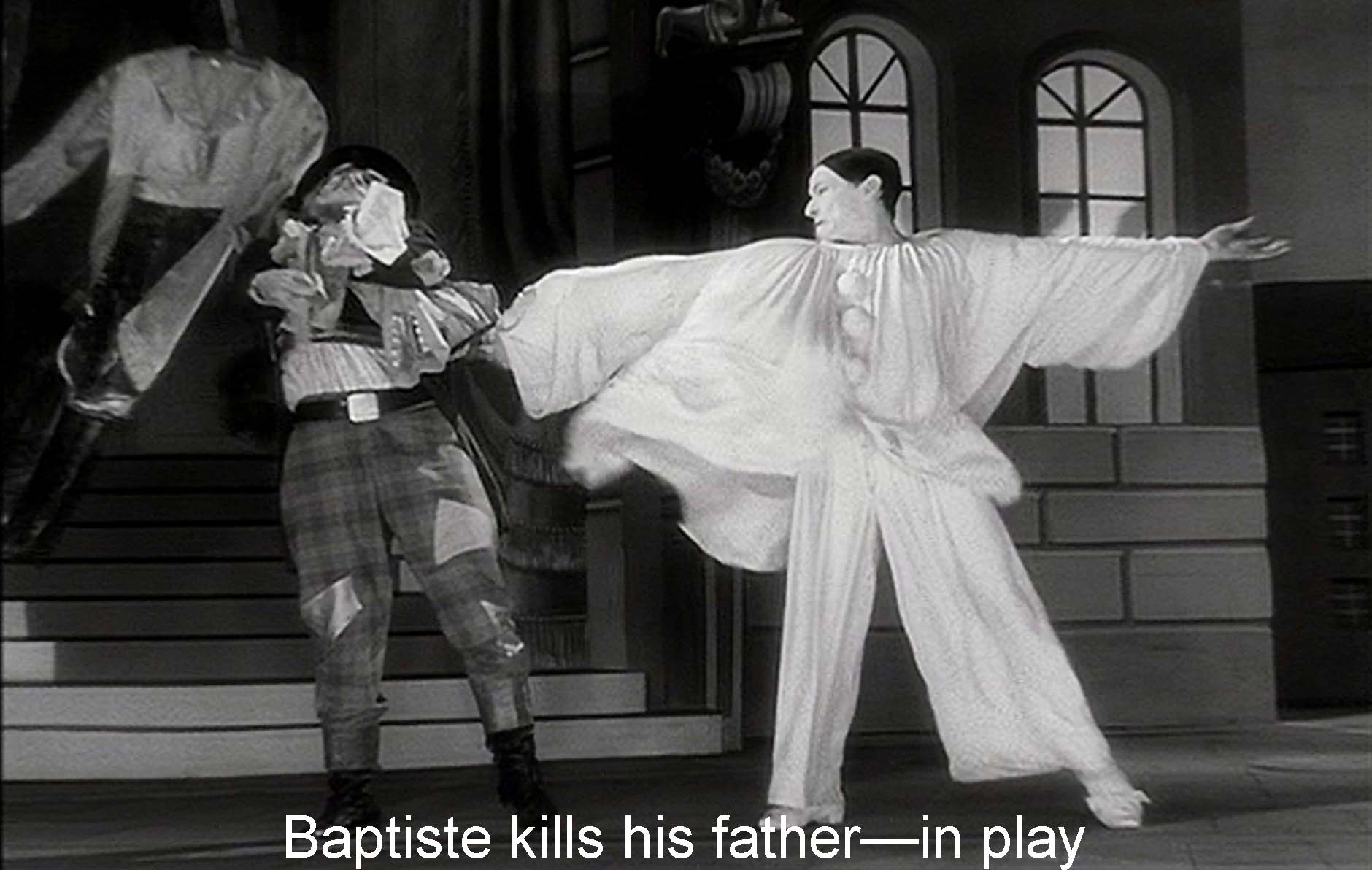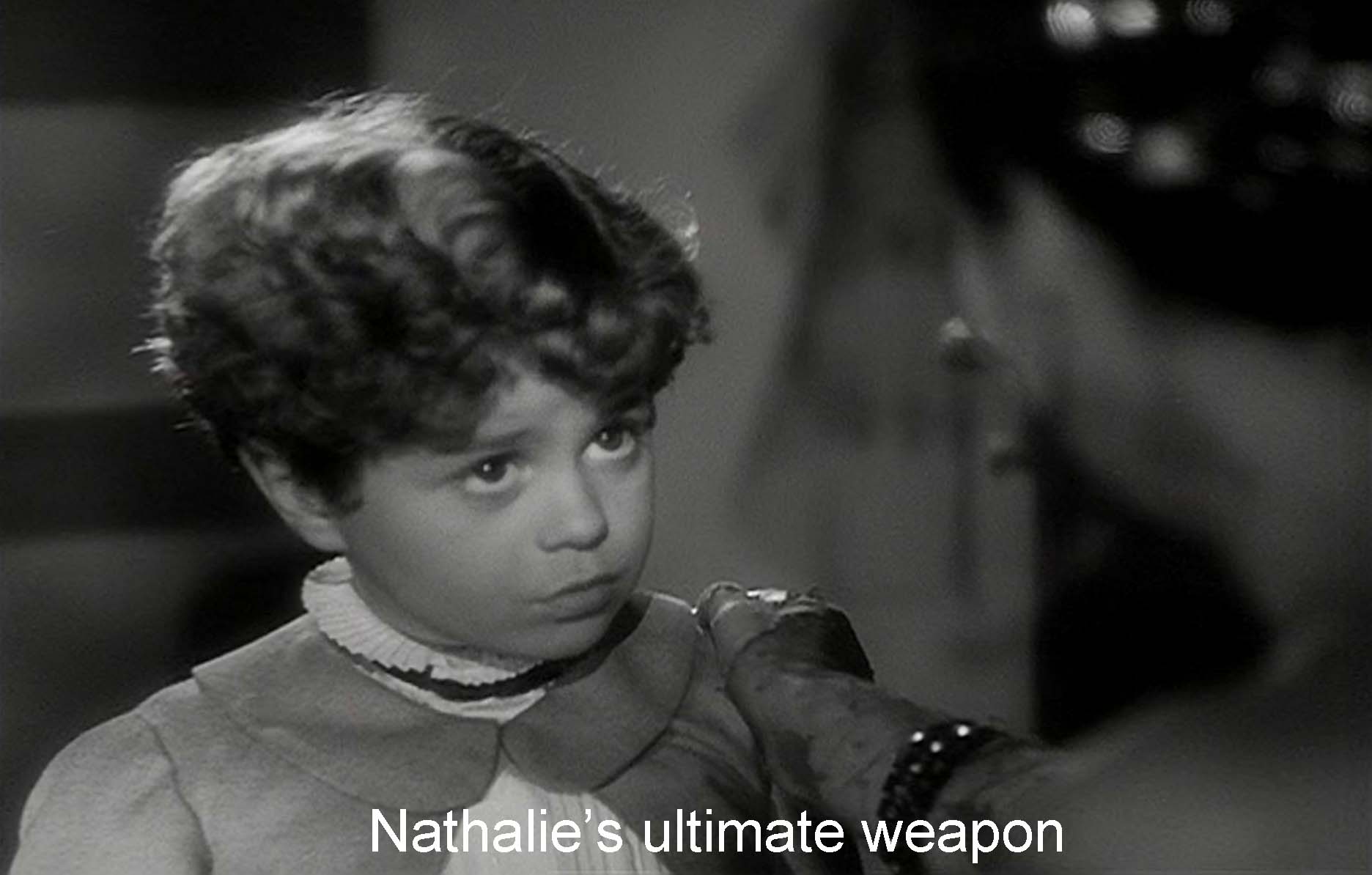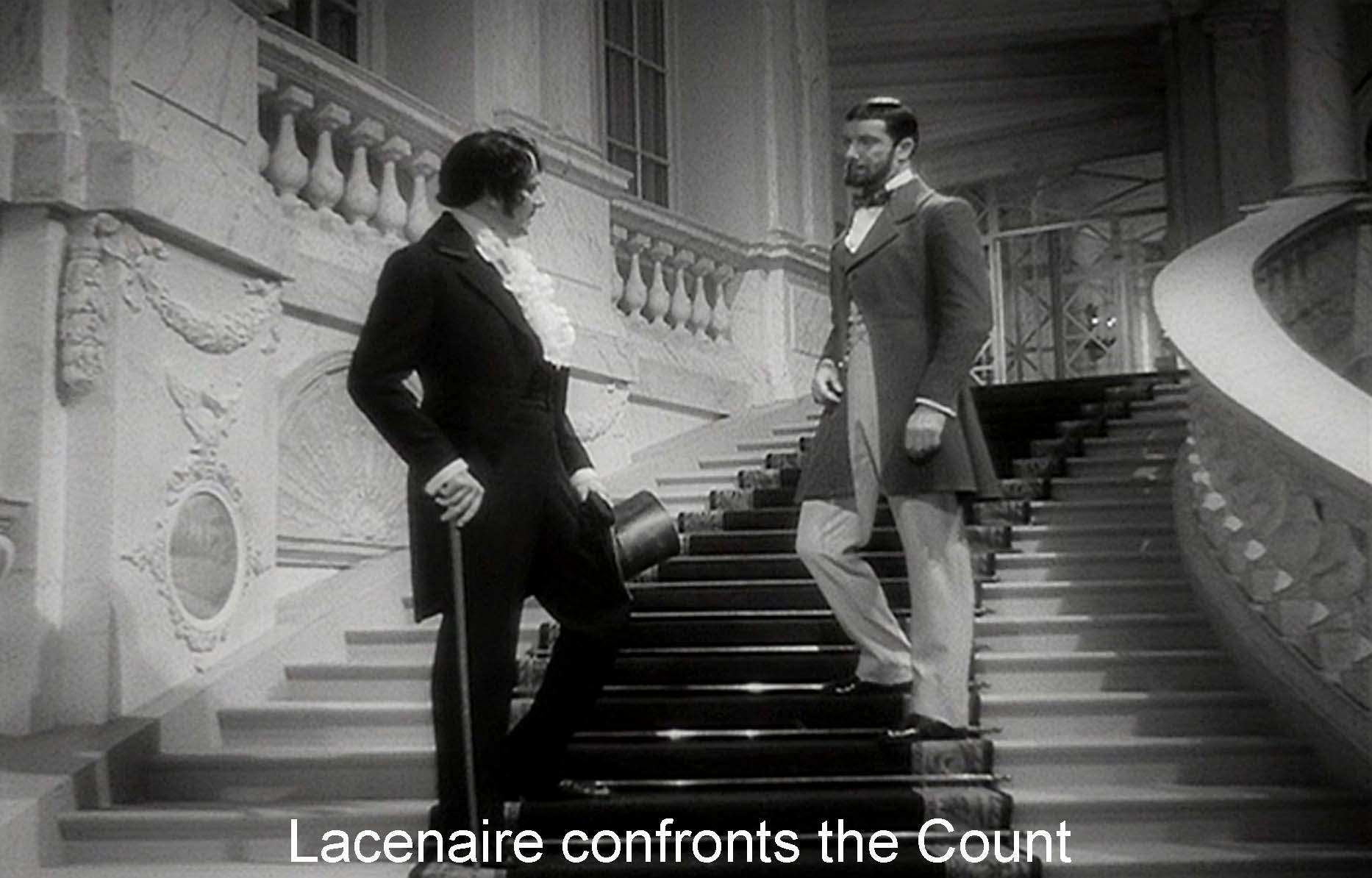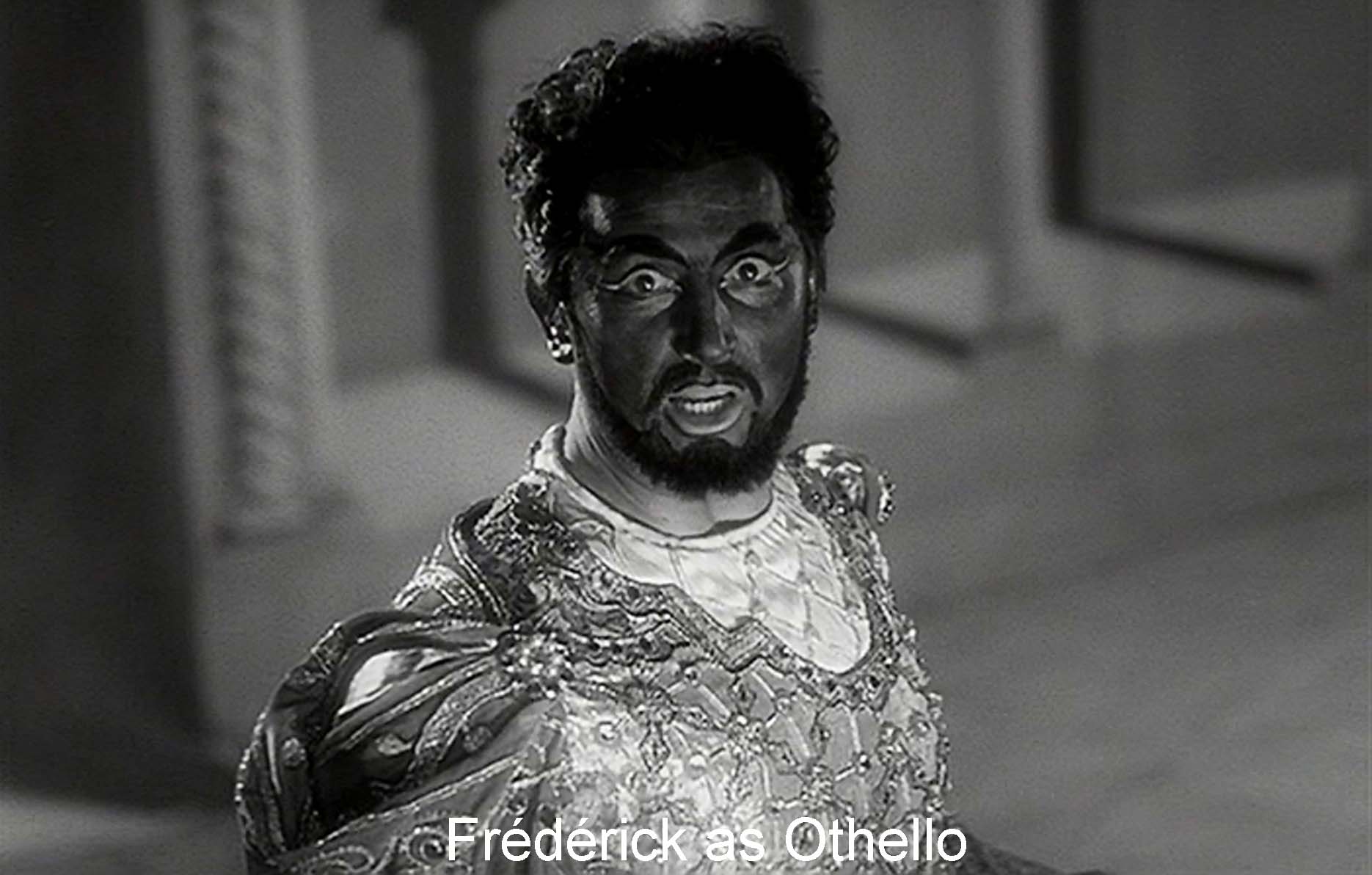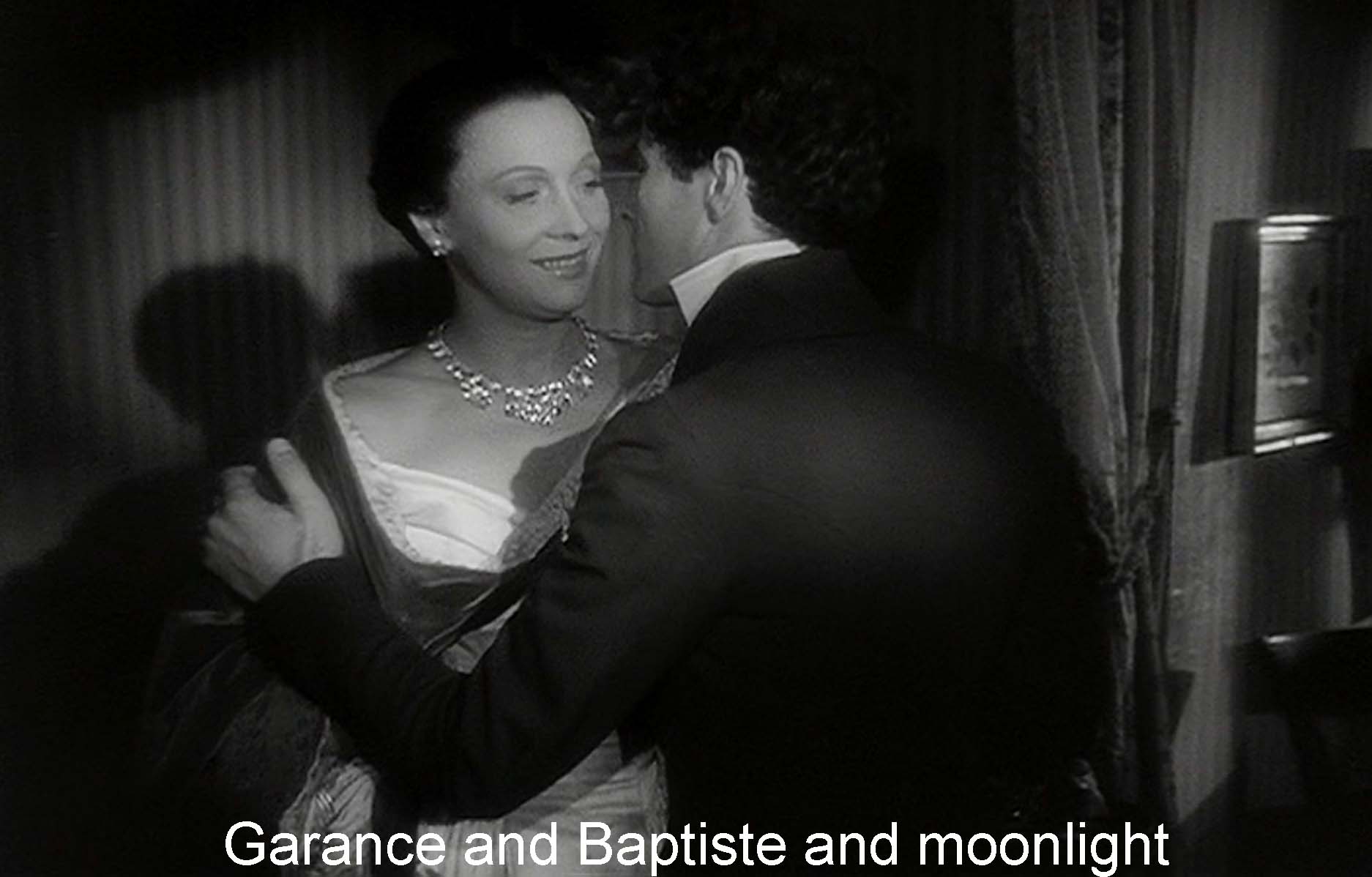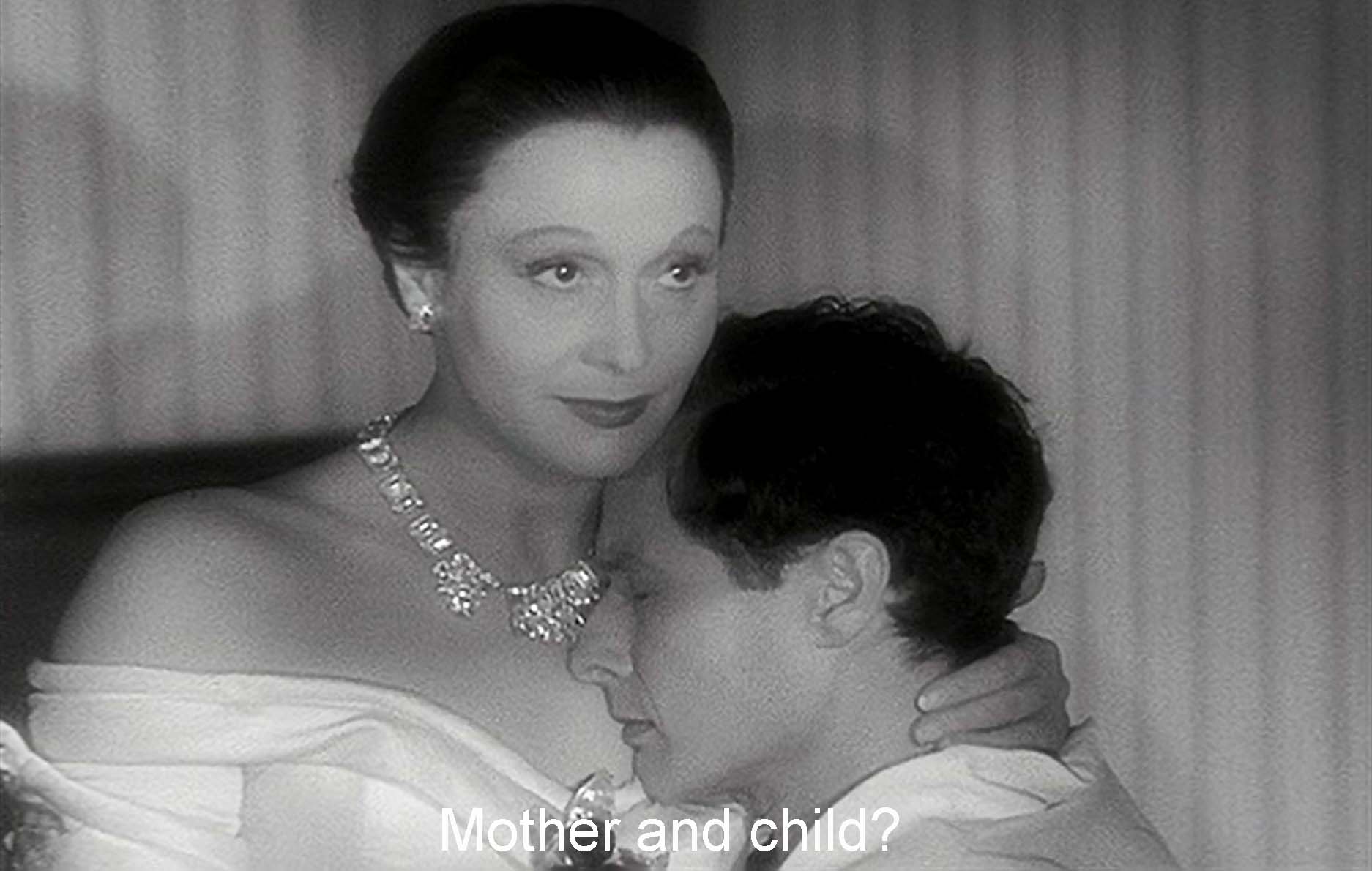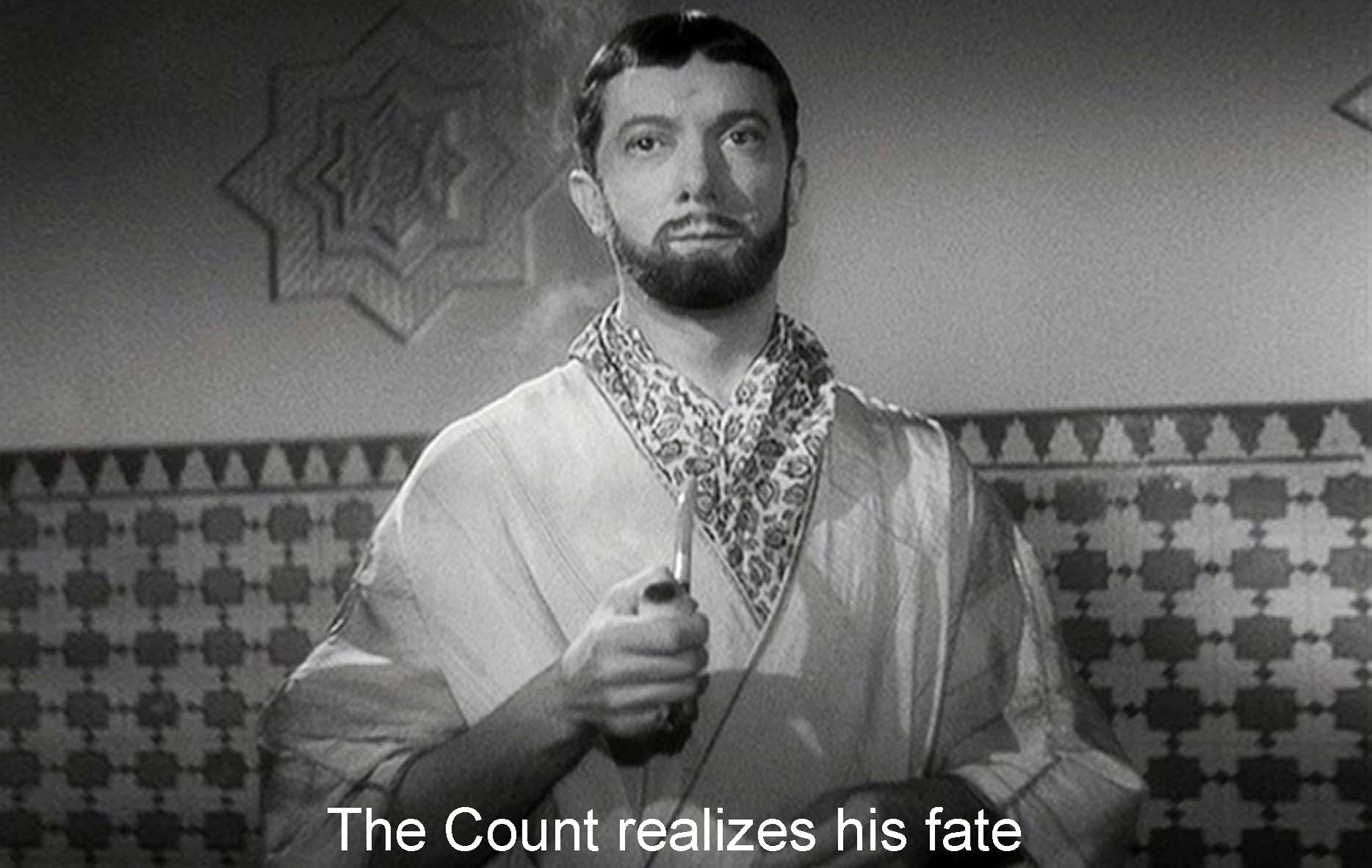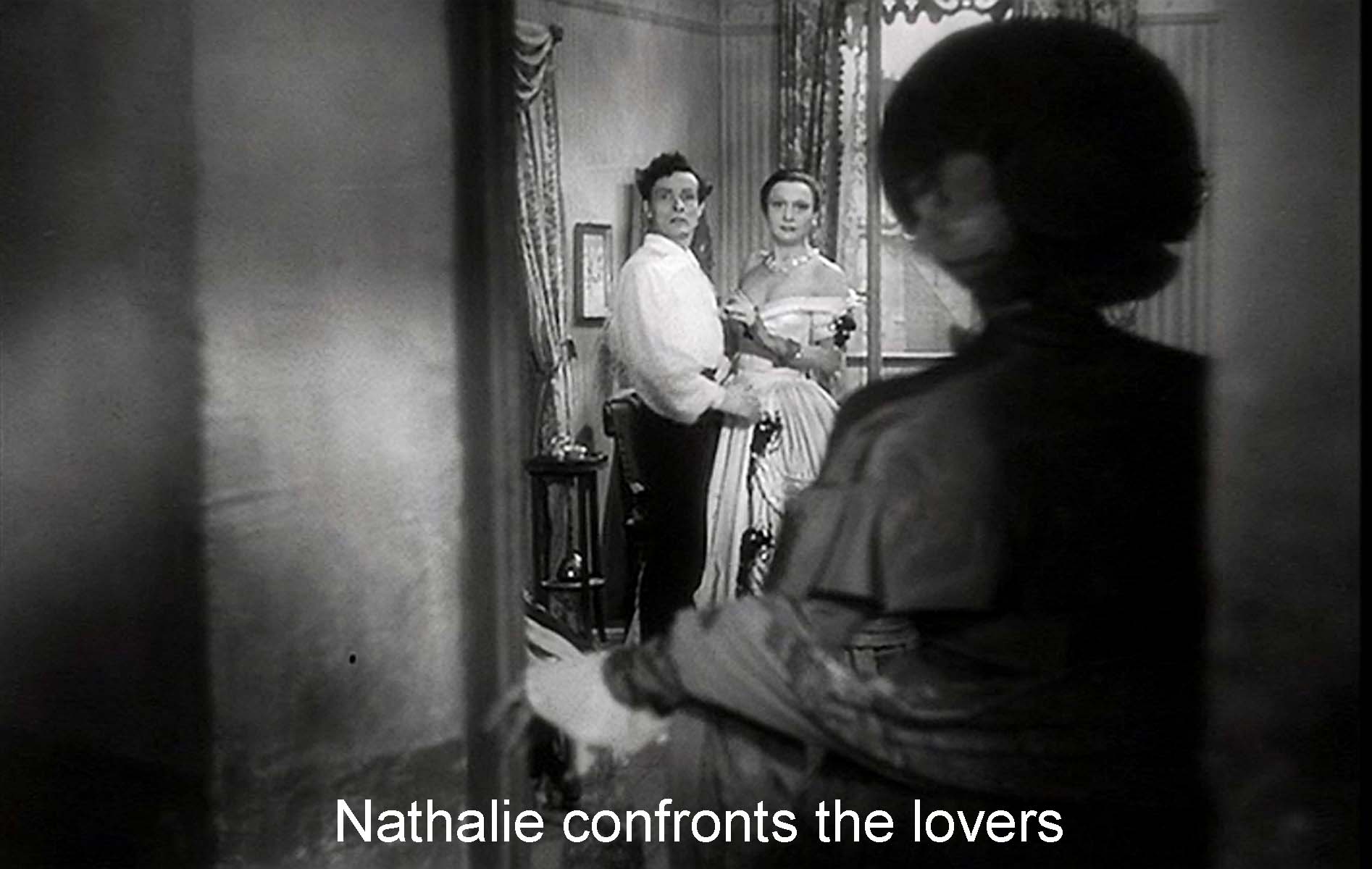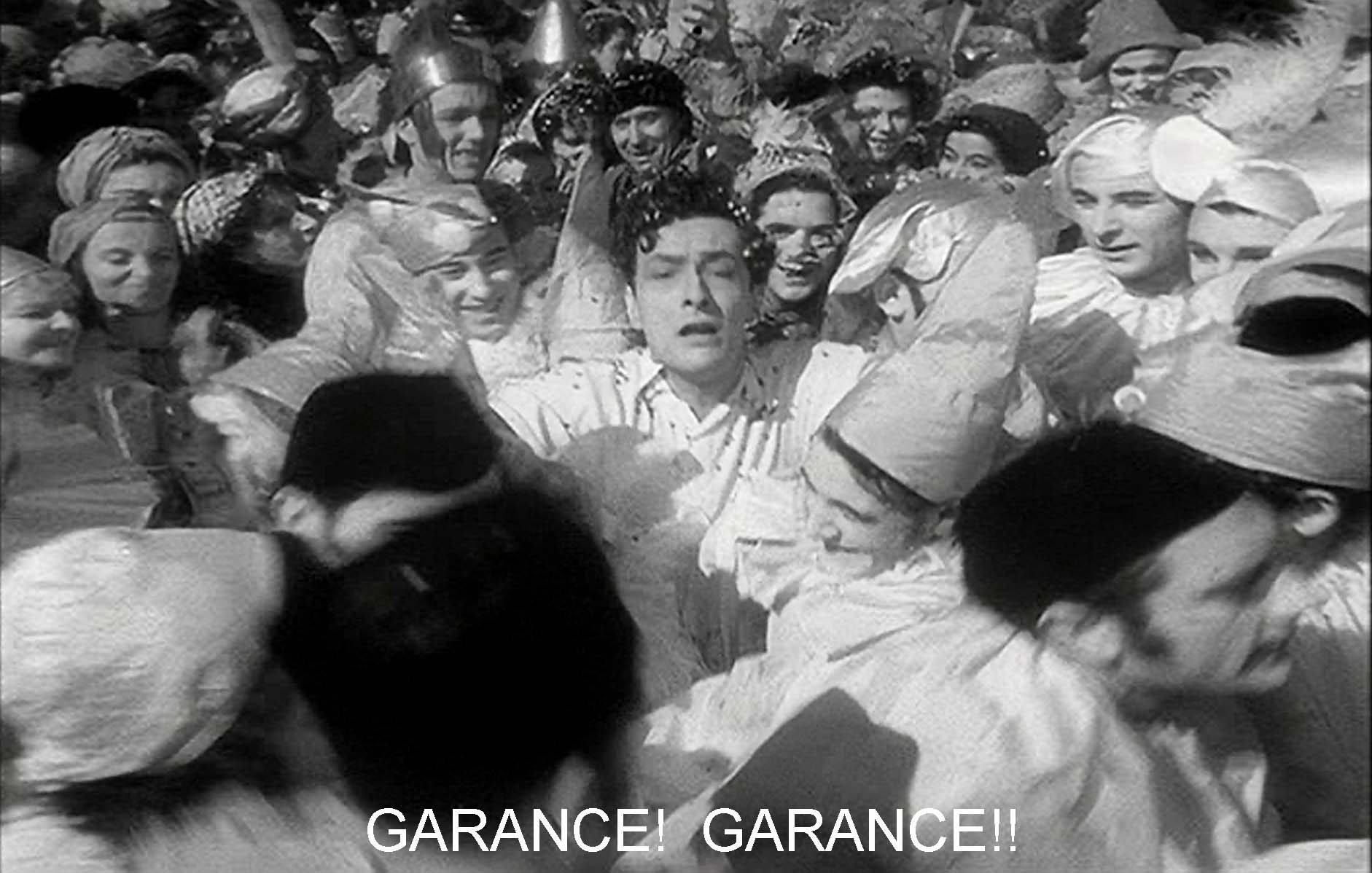A poll of 600 French critics and professionals in 1995 voted this film “Best French Film Ever,” and many surveys since then have dittoed that. Oddly though, this masterpiece of film is almost an anti-movie. It announces itself as theater. When it opens, we hear the three knocks that traditionally announce the beginning of a play in the French theater, and the fake curtain on the screen rises. An hour and a half later, there is a break for intermission. Then an old-fashioned title card, as if from a silent movie, says, “Several years passed,” dividing this three-hour film into two “acts.” The ritual three knocks and a theater curtain rising begin the second act and a curtain falls at the end, all saying, in effect, You are really watching a play. And you do watch plays in this movie, even though Carné opens his film, after that fake curtain, with a scene that could only be a movie: a long pan and tracking shot over thousands of extras in a huge outdoor scene.
IT’S ALL MEDIA, ALL THE TIME
Nevertheless, Les Enfants gives us at least five different theatrical performances. The movie begins with the lowest level of theater, the street fair, rises to two of Baptiste’s sophistications of the lower-class mime theater, then to boulevard melodrama and farce, and finally climaxes with an elaborate Othello in the Grand Théâtre.
Les Enfants also builds on reality. Some of Les Enfants’s characters are historically real with their history embellished by legend. Edward Baron Turk spells out the history in his 125-page discussion of this film. (I will be drawing extensively on Professor Turk’s definitive treatment in what follows—see the occasional page numbers.) Frédérick Lemaître was in fact a leading actor of the period and, like his onscreen representation, extraordinarily flamboyant and reckless in style. The silly melodrama that he turns into a farce, L'Auberge des Adrets was in fact a real play. Othello played a key role in French theatrical history. Traditionalists (like Count Edouard) maligned this particular play and Shakespeare in general, because they did not follow the neo-classical rules for unity and decorum. And Shakespeare played a key role in weaning French theater away from those neo-classical rules.
Jean-Gaspard Deburau was a famous mime who revolutionized that art, transforming the commedia dell’arte’s naïve Pedrolino into the Romantic, lovelorn Pierrot. He devised the black skullcap Baptiste wears in his more dramatic mime scenes in the film (220). The Romantic poets and critics, Turk notes, loved the idea of this new Pierrot. Théophile Gautier, for example, wrote in 1842 (to Frédérick’s furious envy in this film) of “Pierrot, walking in the street in his white blouse, his white trousers, his floured face, preoccupied with vague desires—is he not the symbol of the human soul still white and innocent, tormented by infinite aspirations toward higher spheres?” (256). This is the Pierrot who longs for the moon—and Garance.
Even the thief Pierre-François Lacenaire and his henchman Avril are historical. Lacenaire is the “dandy-assassin” or dandy du crime, another figure appropriated by the Romantics, with their admiration of unbridled, Byronic will (271). Dostoevsky, for example, read the historical Lacenaire’s memoir and described him as “a phenomenal, mysterious, fearful yet interesting individual.” Like Raskolnikov, he thinks himself above morality.
Les Enfants grounds itself in history, but it is a film about media. It feels like one of those great, sprawling nineteenth-century novels that Henry James called “loose baggy monsters.” Had Dickens or Balzac made films, they would have made this film with its cast of thousands, its core of simplified, almost caricatured central characters surrounded by a host of subsidiary figures, its black-and-white plot of interrelated repetitions and contrasts, its probing of high life and low, above all, its theatricality. Professor Turk points out that the opening track and pan along the Boulevard du Temple in Paris of 1827 with some 2000 extras is “the cinematic correlative of the panorama, a mode of perception that came to the fore in both literary and visual depictions of Paris in the mid-nineteenth century” (229).
Also, like those big novels, this film looks at all levels of society. It begins with the wretchedly poor people in “le paradis,” the cheapest seats at the very top of the theater. The pantomime itself came about because the oppressive bourgeois government (established by the Bourbon Restoration of 1814), fearing the unrest of the poor at these theatrical performances, forbade the actors to say a word, a single word!, from the stage. The film rises from that lowest level of society to the luxurious hôtel particulier, where Count Edouard, crème de la crème, has housed his mistress. Again and again, Carné uses a characteristic shot: one character standing higher or lower than another indicating social or moral superiority. Like Dickens or Balzac, Carné ranks his people and judges them.
Filmic techniques Les Enfants reserves for “life,” while the camera often sits like the cameras of the earliest films to “watch” theatrical scenes, recording them for posterity. And I think they merit it: Barrault’s mute acting in his mime scenes seems to me great theater and, in its exotic way, an homage to early silent films. That is another reason this film will seem “classic,” even old-fashioned, to someone seeing it for the first time today.
THE CLICHÉS
It will seem old-fashioned too because of the traditions and rituals in this film: theatrical conventions, conventions of the duel, conventions of the aristocratic “arrangement” for a mistress. “Rituals”? “Clichés” is more like it. Each half builds on a romantic triangle or, more properly, quadrilateral. A loves B who loves C who loves D.
The movie is full of staginess, clichés, and sentimentalisms, but set in the wildly strange and improbable world of the Boulevard du Crime. The movie builds on the age-old triangle of Pierrot-Columbine-Harlequin. Pierrot is the dreamy naif. Child-like, he longs for the moon. Harlequin is the clever, worldly-wise con man. Garance is the woman they both desire, Pierrot purely, Harlequin carnally. Art imitates life or vice versa. The film shows us parallels between Frédérick and Harlequin, Garance and Columbine, Baptiste and Pierrot. The fragile-looking Baptiste, surprise!, surprise!, can fight like a tiger and dares to engage and beat up the bully Avril. That’s one of the clichés: Baptiste is the “oaf son” or the “third son” of many a folktale. This mute, shy boy for whom his father has only contempt, succeeds best. He outdoes not only that brutal father but that great show-off, the actor Frédérick.
In another cliché, Ms. Right, Nathalie, is boring, but Ms. Wrong, the glamorous, unattainable woman, Garance, leads to misery and, in the end, devastation. There is one cliché after another, but one can find simple comfort in clichés. I think that is one reason the film is so popular.
Two other characters affect this eternal triangle. Psychologically, all the men are in a struggle against “the world” or “Fate” or “the Father”—whatever says you cannot have the thing you want. Here, it is Jéricho. In the film’s pre-production treatment, he is called “a messenger from the underworld,” and he does indeed seem to embody a malign destiny. An informer and black-marketeer, he represents all too well the world of Occupied France, Turk suggests. In Part II, Baptiste’s real father, the abusive Anselme Deburau, plays the Old-Clothes Man in another, even darker mime that Baptiste has written. In this one, Baptiste kills not only his nasty, foolish father but also the Old-Clothes Man. He wants to pursue the idealized, unobtainable woman he loves. Oedipus in pantomime.
I see too another “father,” a benevolent, desexualized father-prophet, the pseudo-blind beggar and fence, Fil de Soie (Gasto Modot). A balance to Jéricho, we see him in the Paradise, the topmost balcony, cheering Baptiste on.
THE FILM SPLITS
Carné and famed screenwriter Jacques Prévert divide their film decisively into two halves. The first deals with low life, the second half with high life, marked by the much grander theater curtain that opens it. Part I is fast, while Part II tends to be slower, more static, more drastic.
In the first half, Nathalie loves Baptiste. She represents the familiar: the pantomime and a bourgeois life, marriage to the boss’s daughter, and raising a cute little family. Baptiste, however, loves Garance, his romantic unattainable ideal, unattainable by him anyway. Garance is sleeping with Frédérick.
The second half has Nathalie again representing the familiar, inhibited world that is Baptiste’s destiny: pantomime and the claims of marriage and family. She again loves (and claims) Baptiste, although he still loves his ideal, Garance, and Garance, now, acknowledges that she loves him.
In this second half, as in the first, all the characters from low life (Baptiste, Frédérick, and Lacenaire) reach out toward Garance. She, however, is owned by the richest of them all, the Count, Edouard. The triangle is between the rich man and all of the men who work, who are of a less exalted class. And Pierrot-Baptiste still tries to get his Garance away from her “owner,” as he had wanted to get her away from Lacenaire and Frédérick in the first half.
In the first half, all the characters (until the Count appears) work out their rivalries in the rough-and-tumble, poor man’s world of the Funambules. In the second half, the characters’ rivalries beget a social conflict: a rivalry between low, simple, child-like relationships and successful “high” life with adult rivalries and real consequences (like real duels, real money, real sex, real children, and real killings).
In both halves, the film deals with a rivalry over Garance, first introduced to us as “the Naked Truth,” that which all the artists in the film seek. In the first half, the rivalry follows the pattern of the Pierrot story. Baptiste, the Pierrot, is all innocence, sweetness, and naïvete. But true to the old story, the innocent, sincere man loses. Instead, Harlequin, Frédérick, the show-off, the least helpless and least child-like male, wins the heroine. In the second half, the rich, powerful man has her—sort of.
THE BATTLE OF THE SEXES
The women are more consequential. Nathalie clings to husband and son. She really loves Baptiste. Her opposite number, Garance, the fantasy-woman, seems to have no real attachments. At least, she has no daily, permanent relationships like those of a wife or mother. She has dropped Lacenaire and Frédérick in favor of the Count, but she does not love him and openly tells him so.
In the second half, the rivalry between the men doubles, and the outcome is tragic: murder. One powerful man will murder another powerful man, and the law will in turn kill the murderer. A rivalry between two powerful women, Nathalie and Garance then determines the fate of a child-like male, Baptiste.
The two women also compete, the middle-class, family-oriented woman, Nathalie, against the impossibly rich and glamorous Garance. I read their struggle as the woman of reality battling the woman of fantasy. Yet Garance is presented originally as the Naked Truth. She is a sexy truth, though, the kind one fantasizes about. Carné, like many men, Turk notes, tends to polarize women into banal sweethearts or mythically awesome sorceresses (51).
THE NAKED TRUTH: GARANCE
Garance could be a feminist hero. She is intelligent and independent, a power among men. But she has power only because she can so attract and overcome men, because she is that fantasy-woman. “Garance’s truth is her anatomy,” writes Turk (338). She is, on the one hand, always inaccessible, an emblem of liberty, free as a bird (an image associated with her), but she is also “repackaged” for male desires and projections (234, 246, 339).
You can also think (and Turk does) of Garance as a kind of earth-mother, between the sun of Frédérick and the moon of Pierrot. When we first see her, as “the Naked Truth” concealed in a tub of water, Turk suggests, the men circling her watery tub could suggest satellites in an almost gravitational force associated with Mother Earth, the universal womb, a cosmic center, a fountain of life (332).
Turk also reads Garance as an archaic moon goddess, and I, too, think she has as least as much to do with the moon as the earth. She not only acts Diana or Phoebe, the moon goddess, in Baptiste’s mime play, but she also carries traces of the great fertility-goddesses like Persephone, Isis, or Astarte. “Great is Diana of the Ephesians.” Her real names are “Claire” (light, “Claire de Lune,” moonlight) and “Reine” (queen).
In that vein, the film associates her with flowers—the rose she gives Baptiste, the windowbox at Mme. Hermine’s, the bouquet Pierrot offers her in the mime play, immediately after that the immense bouquet with which the Count woos her, the flowers in their mansion, and on and on. But mostly the film connects her with the moon—the moonlight in her love scenes with the “moonstruck” Baptiste and the tinsel moon that is Frédérick’s “souvenir,” the moonlight that illumines the lovers’ final consummation. (By contrast, both times that she leaves are in daylight—reality.) As Nathalie tells us, she “comes and goes away,” like the moon.
As the “Naked Truth,” she stares into a mirror, and she mirrors the men to themselves with her enigmatic speech: “Nothing and everything.” “The past and the present.” “I am as I am.” “I always smile,” she says, like the korai of archaic Greek statuary, the virgin goddesses who are also destroyers. She acts as a mother to Baptiste, and she brings death to those she favors in the eyes of Edouard or Lacenaire. She embodies the three aspects of the mother-goddess as Robert Graves spelled them out in The White Goddess or, earlier, Freud in analyzing the Three Fates: virgin; bountiful mother (sexual partner and renewable virgin); crone or death-goddess.
Whatever one might say about her, Garance evidences, to my eye, the almost superhuman power of Woman in this movie. Nathalie is powerful, too, but as the aproned representative of bourgeois home and family. There is nothing supernatural about her. Even so, around her, the women form a league. Mme. Hermine hides Baptiste, but tells Nathalie where and how he is. Garance respects Nathalie’s claims as Baptiste’s wife and as mother of his child and twice leaves him on this account. This cabal of women, in my reading, sustains family life against romantic fantasies—as Jéricho, the old-clothes man (Fate? the Father?) also does.
By contrast, there is a network of men in which Frédérick exchanges money or words with Lacenaire and Baptiste and even Edouard, with his clipped, aristocratic accent. This network is highly verbal, and it leads to rivalry and death in the two duels. Where the network of women sustains domestic life, the men in the film are all rivalrous, at cross-purposes, competing for success in the eyes of the public.
WORDS, WORDS, WORDS, AND SILENCE
The movie, as I read it, builds on a contrast between its men and women but also a contrast between words and silence. People are sharply divided into those who speak (Frédérick, Lacenaire, Edouard, Jéricho, Mme. Hermine, the Count and his pals) and those who speak few words, using body language instead (Baptiste, Nathalie, Garance, and the blind beggar).
The two important women talk little. They use the muteness of the pantomime, while most of the men are creatures of words. Jéricho says his prophecies and epithets. Lacenaire writes his plays and makes philosophical speeches about the folly of the world and the cleverness of Lacenaire. Edouard fences with his aristocratic phrasings and accent. Most of all it is Frédérick who delights in words and his own skill at them. Indeed, when he quits his job at the mime theater, he tells the Director he is doing so because he could not speak. “You’ve put a gag in Frédérick’s mouth, and it’s suffocating him!”
The exception among these wordy men, of course, is the child-like Baptiste, who obeys the mime’s discipline of silence. “You’re a wise man,” the blind beggar (or Good Father) tells him. “That’s the best way, never say anything.” Hold yourself in, inhibit yourself. The world punishes us for enjoying in life fantasies that we enjoy onstage, and even there, the world shuts them down (as the bourgeois government muted the poor people’s theater). All kinds of more masculine, more verbal rivals: Lacenaire, Frédérick, the Count, threaten muted Baptiste.
Mime identifies the people of silence: Baptiste and Nathalie. The Latin for “not speaking” is in + fans, English “infant” or French enfant. The mimes Baptiste and Nathalie are the only people in the film who create a child. Moreover, Baptiste is childish himself. When he first appears, his father identifies him as his half-witted child. When he first loves Garance, she says he loves her like a child, and he continues to love her like a child in the second half, crying and trying to possess her. His Pierrot acts out childish failures to possess the woman it is impossible to possess—mother..
Frédérick is just the opposite. A grown-up, sexual man, but psychologically immature, he talks constantly. He personifies words—insincere, feigned words, bluster. In particular, he recites scraps from old plays, words that are not his own, like his “line,” as he flirts with various women. His onstage duel consists of Frédérick fighting the authors of words, pretentious, silly words.
Similarly, Lacenaire begins as a letter writer. He talks all the time, Garance says, like the theater—as opposed to the pantomime. Edouard focuses on what people say about him. He and Lacenaire engage in a war of snidenesses, carried out in the ironic paraphrases and the affected, choppy syllables of aristocratic speech.
The old-clothes man also holds a place in this wordy, worldly group. He is like a Greek chorus. His is the first voice we hear in the picture, and, as an informer, he passes verbal information. Lacenaire calls him “turncoat, twister, Judas, informer.” He gives himself name after name after name: Jupiter (his trumpet); Medusa (the bag on his back); Curse of the Poor; Miser; Rat; the Trumpet; the Horse-Trough; the Kindler, Rake the Ashes, the Piano Tuner; the Dovecot; the Sandman; Sweet Sleep; the Wild Boar; One who Sleeps by Himself; old Papa Joshua; and then, in his final torment of Baptiste, One to a Bed, Modest Maiden, the Bashful One, the Giver of Good Advice, “because I’ve got a weakness for morality.” As a figure of fate, he is neither man nor woman. He is called equally Jupiter and Medusa.
PLAY IT AGAIN
The film itself creates a sense of fate or destiny by its constant use of repetitions. (Répetition is the French word for rehearsal, and, to me, these neat repetitions form part of the staginess of this film.) Baptiste and Garance have their meetings, years apart, in the same room, on the same bed. “Paris is small for those who love as ardently as we”: Frédérick and Garance repeat this phrase when they meet after a day—and after several years. When we first see Frédérick he is trying to gain admission to the Funambules. Years later, as a successful actor, he does the same. The film uses tag-characters in the manner of Dickens or Smollett: Deburau and his family pride; the theatre owner constantly fining his actors; the aristocrats and their staccato pronunciation; the old-clothes man and his names. In general, all the characters are strongly typed. They are caricatures, as in a pantomime or a Dickens novel.
The film repeats symbols as key objects, like the rose Garance gives Baptiste or the tinsel moon she gives Frédérick or the Count’s crested calling card. Flowers occur in several contexts, and there are three “duels”: Avril and Baptiste; the authors and Frédérick; Count Edouard and Frédérick, but that becomes a non-duel, forestalled by Lacenaire. Another ritual performance interrupted.
The film repeats scenes, sometimes contrasting them. At the beginning of the film, Baptiste is a solitary figure in costume, everybody else in mufti. At the end, he is a solitary figure in mufti, everybody else in costume. At the end, he is rushing, they are dancing in place. At the beginning, others were moving, Baptiste was still. In that carnival (the feast before Lent and abstinence), we also get a last glimpse of the old-clothes man—he had been the first character we saw. The last moments of the film spell out the destiny that dominates the characters. The last scene reaches outward in Baptiste’s agonized final cry, “Garance, Garance.” It also closes off a future that the first moments opened. Indeed, at the end, the curtain that had risen for the beginning, falls.
I read these repetitions as saying that the characters, onstage or off, are following predictable patterns the way actors or pantomimists follow a script, but then so is the movie itself and the drama on which it is based. The Baptiste-Garance-Frédérick (or Edouard) triangle follows the Pierrot-Columbine-Harlequin triangle, the base for many commedia sketches.
THE PIERROT DRAMA
The Pierrot drama comes from the commedia dell’arte of the Italian Renaissance and earlier medieval plays. In a common plot, foolish, trusting Pedrolino longs for Colombina, but clever, nimble Arlecchino beats him out. In the early twentieth century, an influential group mostly at Cambridge University, the “myth-and-ritual school,” Gilbert Murray, Jane Harrison, Lane Cooper, Francis Cornford and others took thinking about classical literature in a new direction. They traced the Italian commedia dell'arte back to Roman Comedy, back through Greek New and Old Comedy, and even further, to unwritten fertility dramas. While these scholars’ views have fallen out of favor, I still like to believe them. Se non è vero, è ben trovato. If you are interested in this genealogy here are more details.
According to these “ritualist” scholars, the core drama of Les Enfants draws from a much deeper well than its seeming source, the Pierrot pantomime. It comes from rituals deep in human history, myth, and psychology, fertility dramas designed to keep life in the human species.
MAN AND BOY
That’s why I read the structure of the film in terms of another age-old pattern. The first half, focused on the pantomime theater, deals with infancy (not speaking), a “child” (Baptiste) trying to possess all to himself a “simple” woman he has idealized into an impossibility. The second half, focused on the acteur and spoken theater, deals with a murderous rivalry among adult men over women they possess sexually, not childishly, and between adult mothers over children and the (childish?) men who will father them.
As I read it, the film’s structure mirrors the conflict between the child-in-us and the adult, between the integrity and relentlessness of childhood desire for a mother, and the compromises necessary in adult life, even a quite successful one. Nowhere is that compromise more apparent than in the paradox of loving a woman. The naive youth (Baptiste) demands that she be young and beautiful (and amorous Mme. Hermine complains of this). Experienced men, the Frédéricks of this world (Ben Franklin, for example), know they had best love a mature woman and skip the idealizing, idolizing fantasy.
On this reading, the first half of the film dramatizes the world of the child, big hopes, big fantasies, and big ambitions, while the second half of the film presents the grown-up world of ambiguities and compromises. Contrast, for example, the “duel” between Avril and Baptiste in the first half—silent, with fists, nobody really hurt, the good guy wins. By contrast, the two duels in the second half are wordy and formal. They lead to wounds and death, and it’s hard to say whether the good guys win or not. Modern drama gets more complicated than a simple fertility ritual.
DESTINY: JÉRICHO
Outside all these patterns of eiron-alazon or child-adult stands the old-clothes man Jéricho. He is a fate-figure, intervening at moments to change the characters’ lives or to comment on their fates. Like the other men—not Baptiste—he acts by talking. Both on and offstage, the old-clothes man fits people into pre-existing roles in life (as when he reads palms or tries to tie Baptiste down to Nathalie). Several of the characters, Lacenaire, Baptiste, Edouard, wear the same clothes over and over. Costumes stand for roles—hence the old-clothes man. Once this costume was somebody else’s, now it’s yours. Everybody plays a part. All the world’s a stage.
From that angle, Jéricho seems to me to represent the society—the world— that can determine and define us, as demonstrated by his globe-like face and his many names. He holds junk and secrets, like people in the world. He proclaims that he is a moralist, and he manipulates Nathalie in the name of morality, but he stands for a narrow bourgeois morality. And the moralist himself is corrupt, a spy, an informer, a dealer in stolen goods, as the Vichy bourgeois often were—or as children can feel fathers are. Jéricho is a city of walls, the obstacles that our characters face in the world. Interestingly, the character Jéricho never speaks to Frédérick, although the two pass each other in the opening shots, on the first day, these characters whom one can read as representing, respectively, the stage and the world.
THE FIGURE IN THE CURTAIN
Like Jéricho and Frédérick passing each other at the beginning, in the basic pattern of this film, life and the stage intrude on each other. The film, writes Turk, “presents a world in which twin theatrical sources, the commedia dell’arte and Othello, thoroughly govern human relations” (230). Throughout, the characters live destinies like roles derived from the theater, ultimately the commedia dell’arte with its deep mythic and psychological roots. Baptiste is Pierrot, Garance is Columbine, Frédérick is Harlequin, Edouard is the rich cuckold, Pantaloon, and Lacenaire the grotesquely mustachioed villain. At the same time, Edouard is Othello, Lacenaire is Iago, Garance is Desdemona, and Frédérick is Cassio (although he plays Othello onstage).
At the same time, life erupts into the theater. “We act on a volcano,” says the Funambules’ owner. Frédérick’s creditors and his quarrel with the authors lead to his improvising “against” their play. Flirting with Garance when she is obviously in love with Baptiste, Frédérick feels “jealousy” for the first time, and that, he says, allows him to play Othello. Earlier, when Baptiste sees Garance and Frédérick flirting offstage, his pained and jealous expression causes Nathalie to break the silence of the mime.
It is in this scene, Baptiste’s acting in his mime play and seeing Garance and Frédérick offstage, that Carné’s camera marvelously illustrates this movie’s tension between theater and film. We watch the onstage mime play as though we were sitting in the audience. A relatively motionless camera records the action on the stage from the middle distance. But, at the moment when Baptiste begins to see Frédérick and Garance as lovers offstage, the camera does what only a camera can do—close-up. We move from the stage to life, from theater to movie. Nathalie breaks the silence of the mime, reminding us that movies have sound; mime doesn’t. As often in this film, something is happening simultaneously backstage, on stage, and in front of the stage in the audience.
The pattern is that events offstage will constantly break into the events onstage. I think, in fact, something interrupts or distorts all the theatrical performances, most notably Frédérick’s turning the melodrama in which he is acting into metatheatrical farce by referring to the writers’ role in creating the absurd plot. The one exception is Baptiste’s opening improvisation on the theft of the watch—and that was entirely prompted by an event offstage. That is, of course, Baptiste’s great talent: he uses what he has learned on the streets to create his pantomimes, as by his looking around at night life and learning from the blind beggar. He makes life into theater. So does Frédérick, when he learns how to play Othello by finding his own jealous feelings toward Garance.
WATCHING SEX
As one would expect with all the theater in Les Enfants, the characters (and we) do a lot of spying and looking (as the Nazis were doing on the set as the film was being made). Jéricho snoops and interferes, as does Lacenaire. The police pry and make mistakes and false arrests (in what is possibly a poke at the Gestapo). Baptiste carries on his nighttime investigations. Even Baptiste’s little son stares at the beautiful Garance, as the loiterers had stared at the Naked Truth. Child-like Baptiste, however, is frightened by nakedness; when Garance starts to undo her dress, he runs away.
I could stand outside this film, as it were, and say, in my professional role as psychoanalytic critic, that it’s about a child’s recollection—or fantasy—of looking at people having sex, the “primal scene” in psychoanalytic jargon. (Professor Turk also picks up this theme.) Interestingly, almost like a psychological regression, all four of the major characters (Baptiste, Garance, Frédérick, Lacenaire), tell us about their childhoods. Psychoanalysts think that primal scene fantasies, evidenced by a fixation on looking, underlie a later preoccupation with theatrical performances and movies. Thus, in this film, the action takes place largely in two kinds of places: theaters and bedrooms. Thus, the theater curtains that punctuate the film, the curtain pulled aside to reveal Baptiste and Garance embracing at the Grand Theâtre, Nathalie bursting in on Baptiste and Garance, and so on—all show us people witnessing sex. The sex watched or suspected involves betrayal or vice.
Much of the film’s spying and looking is associated with the theme of cuckoldry, notably in the Count’s suspicions about Garance’s past with Lacenaire and Frédérick. When Frédérick makes love to the woman Baptiste loves, Baptiste’s preposterous father happens to have just said, “I tell you—the same laurels that decorate the head of the father have grown overnight on the forehead of my son!” There are the insinuations of the police that Garance is a prostitute.
MASKS, COSTUMES, PRETENSE
Life itself in this film is theater (Erving Goffman’s well-known idea in The Presentation of Self in Everyday Life). Throughout the film, people pretend. Either they pretend professionally on a stage or simply in society: Frédérick’s flirtations; the pretensions of the director of the Funambules and his mimes; the poses of Lacenaire or the Count’s aristocratic friends; even such small details as a robbed debt collector’s pretending to be brave. Smiles abound, but truth is in short supply, confined pretty much to the speeches of three characters: Baptiste and Garance—and the blind beggar. And Baptiste is also blind. He cannot see the Naked Truth for his idealistic illusions.
Before all the masks, the deceptions, mistakes, and theatrical shows, in the opening shots of the film, there was Garance, the Naked Truth—and at the end, there was Garance. Nakedness is truth, all the rest is unreal in a world of costumes, make-up, and disguises. Baptiste, too much the idealist who needs illusions, flees from Garance’s nakedness like Joseph from the wife of Potiphar. He cannot—at first —stand any truth but the truth of romance and theater: costumes and clothing that cover the sexual act.
A THEME
Baptiste’s dreams make a triangle, familiar in the life of any child, and he puts onstage the pain of that triangle of mother, father, and child. His love for Garance mimics a child’s unattainable love for a mother. He suffers for it. He must watch her with other men. He has to stand on a stage and watch her with Frédérick. To be sure, he becomes a father himself. That is less satisfactory, though, than being a child united with that overwhelming, ideal love. And it is to that childish love that he is willing to sacrifice wife and child in the final scenes. Although he does not know it until the end of the film, his—my—fantasy—comes true in the world of the movie. She only seems to love that other man. She pretends. She’s acting. She doesn’t really love him. She really loves me.
At the Grand Théâtre where Frédérick is playing Othello, Baptiste is exposed as the real lover of Garance in front of three threatening men, all involved with Garance in various amorous relationships: Othello-Frédérick, Edouard, and Lacenaire. Nevertheless Baptiste possesses her that night, that one night. In the morning, when Nathalie confronts the two of them with the real demands of bourgeois family life, the fantasy-woman once again yields to the realistic wife and mother. Baptiste has to lose the woman of his dreams—and Jéricho exults over his pain. It’s a child’s fantasy dashed.
Turk sees as a unifying theme for the film: “a consistent aesthetic . . . of incompletion, disconnection, and understatement” (233). He links this sense of incompletion to the men all circling around a Garance whom none of them can ever, really, have.
Why do people care so for this film? Why do we feel emotions about it? For me, it is a film about our ambitions or, more deeply, our desires.
Baptiste, Garance, Nathalie, Frédérick, and all the rest, for all the difference and specialness of their world—the nineteenth century popular theater—for me, they turn out to be characters in an age-old drama repeated lifetime after lifetime. Wanting and getting—some or little or none. Each character wants something: a husband, success in the theater, or simply to live one’s life. And no one succeeds.
They live out the timeless conflict between the overpowering emotional relationships of a child to a mother-and-the-world and the more modest relations of an adult. It is our human fate. Or, as Baptiste’s father ruminates, “Novelty? It’s as old as the world.” Or, it leads to what Professor Turk calls an aesthetic of “incompletion and disconnectedness.” Their drama, be it film or theater, pantomime or Shakespeare, movies or fertility drama, says to me, Your life is already written for you. You think you’re going to be someone special, but, you know?, you will play a role like all the rest of us—those 2000 extras.
